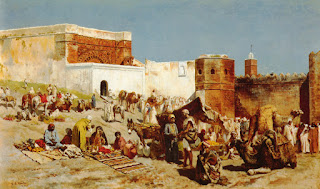Equestrian Polish, Eurasian and the Americas history and horsemanship - from Bronze Age to circa1939AD. Historical equestrian art, my own artwork; reconstructions, and some traditional art media and digital artwork-related topics. All rights reserved unless permitted by 'Dariusz caballeros' aka DarioTW, copyleft or fair use.
Monday, January 30, 2017
Edwin Lord Weeks - North Africa
Salve,
I would like to add some more images by maestro Weeks
this time from North Africa and Western Asia - Persia- I used to like those old Hollywood movies about the tales of the Arabian[Persian and /or Indian] Nights and even the ones about the French Foreign Legion.
back to the subject - in the US there are many, many Orientalist paintings within the vast warehouses of many a museum. But we do not cherish them too much nowadays ..
So let us explore some more the Bostonian's brush work - in addition, you can even read about this travels an adventures in a book he wrote and illustrated himself.
Persia
North Africa
finally the master in his studio
enjoy
Subscribe to:
Post Comments (Atom)















1 comment:
http://truthaboutcamps.eu/th/zaloga-ss-kl-auschwitz/16816,Zaloga-SS-KL-Auschwitz.html
SS KL Auschwitz Garrison
The Konzentrationslager (KL) Auschwitz was set up in the premises of former Polish military barracks at the outskirts of Oświęcim, a town in the western part of the then-Kraków Province. After the outbreak of WW2 it was incorporated into the territory of the Third Reich. The camp was gradually extended and eventually formed the complex of the KL Auschwitz I-III. In 1944, it consisted of three main parts, namely: Auschwitz I - Stammlager (in Oświęcim), Auschwitz II - Birkenau (close to demolished village of Brzezinka, whose population had been forcibly removed), Auschwitz III - Monowitz (in the area of demolished village of Monowice whose population was also forcibly removed) and more than 40 sub-camps. The complex of camps named Auschwitz I-III was the largest of all the Nazi German concentration and extermination camps of the total 29 camps in the territory of the Third Reich and other countries in Europe occupied by Germany.
It is estimated that, in the KL Auschwitz, approximately 1,000,000 Jews, 70,000–75,000 Poles, 21,000 Roma people and approximately 15,000 Soviet prisoners-of-war were killed. In total, nearly 1,100,000 persons were murdered there during the period when the camp was in operation.
This database contains records concerning SS KL Auschwitz personnel who served in the guard battalion and guard companies (SS-Totenkopfsturmbann, SS-Totenkopfkompanie), in six departments of the camp administration (Abteilungen I – VI) and other SS sections and branches under the command of the Commander of Auschwitz I and its SS garrison (SS-Standortaelteste) operating outside the main camp. They included among others the SS Hygiene Institute (SS-Hygiene Institut der Waffen-SS und Polizei) in Rajsko, the SS Central Construction Board (SS-Zentralbauleitung der Waffen SS und Polizei Auschwitz O/S), and other companies or their branches which belonged to the SS.
The database does not contain any personal details of the Wehrmaht soliders who served in some commandos and sub-camps outside the KL Auschwitz as auxiliary guards, 8th company guard (8. ukrainische Kompanie), which recruited mainly Ukrainian nationals, SS Security Service (Sicherheitsdienst) in the training centre for saboteurs Unternehmen Zeppelin (the so-called Vorlager Auschwitz), and SS female guard (SS-Aufseherinnen) alongside other females serving in SS: female wireless operators (Nachrichtenmaiden), sisters of the German Red Cross (Deutsche Rotes Kreuz Schwestern) who did not join the SS.
Post a Comment